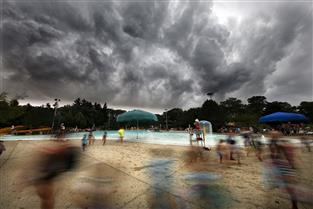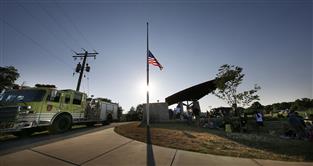Two areas in East Tosa have been chosen as test sites for the city's lateral rehabilitation pilot program.
The results should help city staff identify specific fixes and the associate costs to prevent basement backups, while reducing the amount of clear water getting into the sanitary sewer system.
The first area, North 65th Street from North Avenue to Clarke Street, showed heavy leaks during earlier dye testing, said Dave Bennett, consultant from Brown & Caldwell, which has been working with the city on sewer studies. This area has already seen sewer improvements on the public side so it will give crews an even better idea of the problems coming from the private side.
Right now, consultants believe about 75 percent of all excess water entering the system is coming from the laterals connected from private homes to the city's sewer main.
The second area targets Eagle Street between Wauwatosa Avenue (76th Street) and 80th Street.
The East Tosa sewersheds stand out because they're the only ones in the city that don't comply with Milwaukee Metropolitan Sewerage District's peak flows during wet weather.
"We're in violation," said Bill Porter, city Public Works director. "We need to show some hard progress in 2012 toward reducing that."
Agreement brings in money
The Common Council on Tuesday unanimously approved entering into an agreement with MMSD that would provide the city up to $500,000 to hire Brown & Caldwell to administer the pilot program.
MMSD established a funding program for municipalities to perform repairs on private property that would significantly reduce clear water entering the sanitary sewer, as a direct result of basement flooding that has happened after heavy storms. Between now and 2020, Wauwatosa expects to receive $4 million. Right now, about $500,000 is available and the city has budgeted about $1 million for the program.
The pilot program will determine whether repairs to only the leakiest laterals will fix the problem or if it will simply move the leaks to neighboring homes or laterals across the street, which may not have shown problems in earlier tests. For each lateral that needs repairs, the price goes up if the project expands to the greater East Tosa area and other problem neighborhoods in the city.
Smaller project possible?
In addition, consultants will look at whether the city can get away with relining the portion of the lateral in the public right-of-way, instead of the entire lateral.
Laterals are one contributor to infiltration, but so are foundation drains. The pilot program doesn't address foundation drains but it will show whether the amount of water can be reduced enough without looking at those connections, Bennett said.
With 130 properties within the two test areas, the cost to test and improve each one's laterals comes at about $11,500, a number higher than previous estimates, Alderman Brian Ewerdt said.
The dollar amount should go down on a larger roll out because the pilot includes much of the engineering, studying and inspections upfront, Bennett said.
The next step is to set up a public information meeting with the property owners in the two test areas. Permission will be needed from the residents before work can be done on their property, Porter said.
More from News and Features
- Anodyne Coffee plans to open location in Wauwatosa Village
- Wauwatosa Meetings: Aug. 4
- Video: Wauwatosa girl's curbside ice cream stand raises money for the hungry
- Wauwatosa News and Notes: Hands-only CPR training offered; Firefly Art Fair is Aug. 6-7
- Wauwatosa Ask Now: Why are there barriers and fencing along the North Avenue bridges over the Menomonee River?
- Mystery Photo Contest: July 28
- Wauwatosa gears up for National Night Out event, this year at the zoo
- Election 2016: Wisconsin's 4th District candidates weigh in
- Wauwatosa's Luther Manor residents share smiles through flower delivery
- Wauwatosa Police Report: July 17-23














